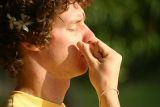Yoga Breathing Techniques
Pranayama (Breathing Practices):
 Prayanama helps to breathe. it enriches the blood with oxygen, which is essential for overall health and vitality. Blood is ‘rich’ when it contains the necessary levels of oxygen and nutrients. Therefore you can enrich the blood through proper respiration and digestion. Pranayama can restore health and vitality to respiratory and digestive functions. It helps to improve the appetite and purifies the system by burning up toxins. It helps to boost the immune system and fight infection. When you breathe deeply the thymus gland, situated in the upper part of the chest behind the breastbone, is massaged and stimulated, restoring proper function. The thymus gland is part of the lymphatic system, the body’s waste-disposal system. The thymus produces lymphocytes. They form part of the body’s white blood cells, surrounding and attacking invading agents or toxins. Breathing deeply massages the heart, bringing health, vitality and physical and emotional healing. The heart rests between beats, so when you slow the breath down the heart doesn’t beat as fast, giving it more time to rest. Pranayama calms and purifies the nervous system. When you take a long, slow exhalation the parasympathetic nervous system is stimulated, triggering the body’s natural relaxation response. It switches off the stress responses from the sympathetic system, which are switched on by stressful situations. It helps asthma and respiratory disorders. In yoga, the asanas gives us control over the body and mind, and awareness inwards. The breath is the link between the body and the mind, bringing both into harmony. When your breathing pattern changes, the emotional and mental state is changed too. When the mind is agitated, the breath fastens. When the mind calms, the breath slows down.
Prayanama helps to breathe. it enriches the blood with oxygen, which is essential for overall health and vitality. Blood is ‘rich’ when it contains the necessary levels of oxygen and nutrients. Therefore you can enrich the blood through proper respiration and digestion. Pranayama can restore health and vitality to respiratory and digestive functions. It helps to improve the appetite and purifies the system by burning up toxins. It helps to boost the immune system and fight infection. When you breathe deeply the thymus gland, situated in the upper part of the chest behind the breastbone, is massaged and stimulated, restoring proper function. The thymus gland is part of the lymphatic system, the body’s waste-disposal system. The thymus produces lymphocytes. They form part of the body’s white blood cells, surrounding and attacking invading agents or toxins. Breathing deeply massages the heart, bringing health, vitality and physical and emotional healing. The heart rests between beats, so when you slow the breath down the heart doesn’t beat as fast, giving it more time to rest. Pranayama calms and purifies the nervous system. When you take a long, slow exhalation the parasympathetic nervous system is stimulated, triggering the body’s natural relaxation response. It switches off the stress responses from the sympathetic system, which are switched on by stressful situations. It helps asthma and respiratory disorders. In yoga, the asanas gives us control over the body and mind, and awareness inwards. The breath is the link between the body and the mind, bringing both into harmony. When your breathing pattern changes, the emotional and mental state is changed too. When the mind is agitated, the breath fastens. When the mind calms, the breath slows down.
The Breathing Process:
Electrical message are sent from the brain through the nervous system to the muscles of the rib cage and the diaphragm. The diaphragm is a large, dome-shaped muscle that separates the chest cavity from the abdominal cavity. These muscles contract, moving the ribs up and outwards and contracting the diaphragm, which flattens and moves downwards. The chest cavity creates a vacuum in the lungs decreasing the pressure and the air is taken into the lungs to equalize the pressure. When we breathe out, the electrical messages stop and then the muscles are relaxed and the elasticity of the lungs causes them to shrink, expelling the air.